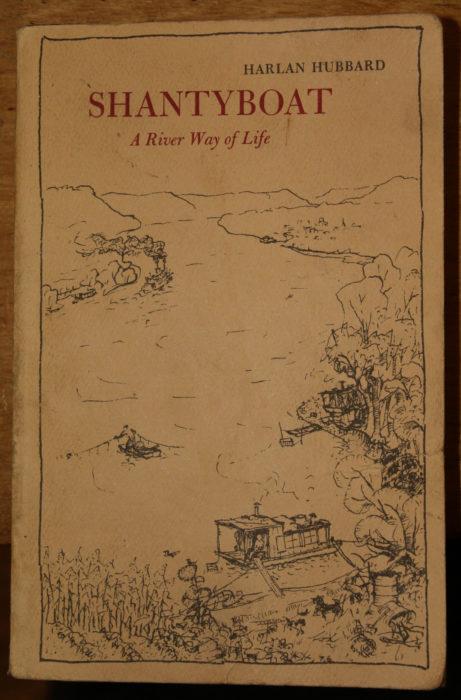 When I was planning for my rowing trip down the Ohio and Mississippi rivers in the early 1980s, I read as many books as I could find on traveling those waterways in small boats. Four Months in a Sneak Box by Nathaniel Bishop was my main guide, as it was his trip that I was going to duplicate. I also read Mississippi Solo by Eddy Harris and Old Glory by Jonathan Raban, both good reads, but Shantyboat: A River Way of Life by Harlan Hubbard was my favorite and most inspiring.In 1944 Harlan and his wife Anna built a shantyboat near Brent, a cluster of houses along a road paralleling the Ohio River just upstream from Cincinnati, Ohio. They stayed there on the banks of the river for two years, living on what they could grow in their garden or catch in the river, and left Brent on the high waters of November 1946. They stopped for the summer in Payne Hollow, about 120 miles downstream, and stayed there for the summer of 1947 before moving on. They reached New Orleans in 1950 and stayed another year in the Louisiana bayous before returning by car to Payne Hollow in 1952. They settled there, building a house and a life for themselves.
When I was planning for my rowing trip down the Ohio and Mississippi rivers in the early 1980s, I read as many books as I could find on traveling those waterways in small boats. Four Months in a Sneak Box by Nathaniel Bishop was my main guide, as it was his trip that I was going to duplicate. I also read Mississippi Solo by Eddy Harris and Old Glory by Jonathan Raban, both good reads, but Shantyboat: A River Way of Life by Harlan Hubbard was my favorite and most inspiring.In 1944 Harlan and his wife Anna built a shantyboat near Brent, a cluster of houses along a road paralleling the Ohio River just upstream from Cincinnati, Ohio. They stayed there on the banks of the river for two years, living on what they could grow in their garden or catch in the river, and left Brent on the high waters of November 1946. They stopped for the summer in Payne Hollow, about 120 miles downstream, and stayed there for the summer of 1947 before moving on. They reached New Orleans in 1950 and stayed another year in the Louisiana bayous before returning by car to Payne Hollow in 1952. They settled there, building a house and a life for themselves.
Join The Conversation
We welcome your comments about this article. To include a photo with your remarks, click Choose File below the Comment box.

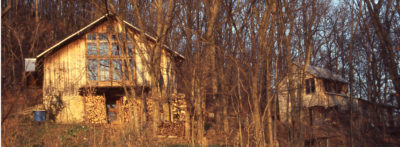
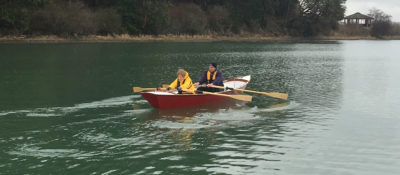
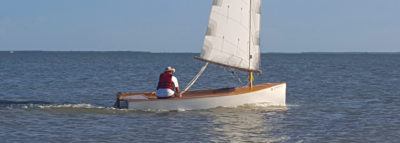
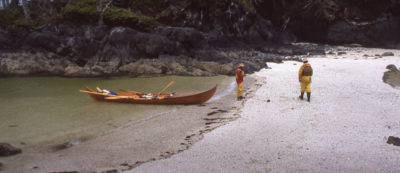
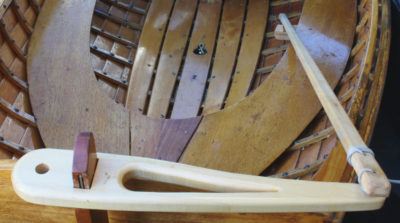
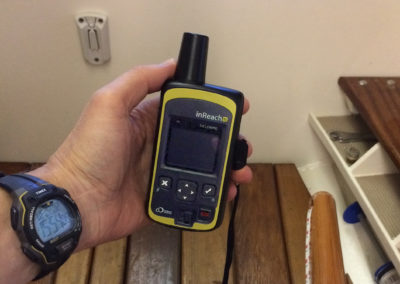





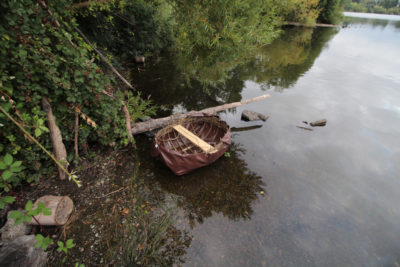
Thanks for sharing this memoir. I have enjoyed two of their books and I’m glad to know a little of their later years. And thanks for sharing this story in such a tender way.
This is a touching story; it’s remarkable that you were able to meet them. Inviting a stranger to stay the night in their home causes me to think that they must have been kind, generous people. There are still people like that today; this story is a reminder that the world is not all bad.
In all of my travels I’ve found people everywhere are quite accommodating. In 7,000 miles of coastal and river cruising I could count the inhospitable people on one hand and still have my thumb and index finger left over.
I think there is a special sense of community along waterways. It also helps to be traveling in a small boat, especially under human power. I knocked on the door of one home on the St. Marys river on Christmas Day, just to get water and was was invited in for Christmas dinner. An elderly woman living alone near the Intracoastal Waterway just south of Charleston South Carolina came to her front door after I knocked, took a look at me, then a look at my canoe and said, “Honey, ain’t never been a thief come by canoe. Come on in.”
Thanks for sharing the memory. Lovely story nicely told. And nice stewardship of available resources. Tell us more (or point to where you have already) about your Bishop/Sneakbox adventures.
I have Shantyboat, Shantyboat on the Bayous, and Payne Hollow, as well as the DVD Wonder. I treasure and have enjoyed them just as I did my wonderful illustrated copy of Swiss Family Robinson I once possessed as a boy. All were filled with tons of practical solutions, ingenious contrivances, and field expediencies that were thrilling to read—to say nothing of the exciting locations and fanciful encounters with both local creatures and local peoples. I’ve never traveled by oar, though I built a rowing skiff with my grandson for him and his friends on Puget Sound and I’ve fished most of the Sacramento and put my line into many other waters across the country and deeply love the live water found in rivers and streams. Thank you to Mr. Cunningham for reinvigorating the pleasure I’ve found hearing of the lives of the Hubbards.
Hi Chris. Another interesting read is On the Water: Discovering America in a Rowboat by Nathaniel Stone. He too reminisces about the Hubbard’s shantyboat trip down the Mississippi although to my knowledge he did not meet them as you did.
Nat started his trip in NYC in a single scull and between taking shortcuts and portages got to the Mississippi delta at New Orleans where he took a break. He returned in a more traditional rowboat to ply his way in the Gulf and then up the East Coast back to New York City. The change in craft was dictated by the need to be able to sleep aboard in the less hospitable parts of the country.
Not done, he left NYC and was determined to reach Eastport, which he did after being denied passage through the Cape Cod Canal. Undaunted he completed his goal by rowing around the Cape and reached his final destination.
So did they ever have to leave their house because of flooding? Not too worried about that here in DownEast Maine, though the lobster dock I manage should have been built a foot higher as it is almost under water on big tides now.
Many of the towns I stopped in along the Ohio River had markers to show the river level during the Great Flood of 1937 where the waters reached 79.9′ above flood stage. In his book, Harlan writes about a previous homestead in Payne Hollow: “House and barn were carried away by the 1937 flood.” So they knew about the Great Flood. Later he writes: “From the beginning we had determined it [the house] should be above flood level.” None of the neighbors could tell the Hubbards where the flood waters had reached, so Harlan and Anna used “a carpenter’s square, a piece of string with a weight on it and a tape line…to calculate approximately the elevation of the chosen site above the normal pool of the river. The Ohio is never expected to exceed this mark and we hope this is a true prediction, but for our part, flood water in the cellar would be a small price to pay for the sight of the river grown to enormous size, extending from our hill to those on the far side, covering the tallest of trees.”
Chris, thank you for your exceptional article! I don’t know how I missed this article in March. I grew up reading Shantyboat. It was one of the earliest books I can remember reading, and Payne Hollow is a classic in its own right from the ’70s. My grandparents’ home was right next door to Harlan’s brother, Frank, in New Rochelle, N.Y., so we heard regular stories of Harlan and Anna’s exploits when Frank and his family would come to dinner, though I never did have the pleasure of meeting Harlan or Anna themselves (I was a young boy at the time). Frank, Jr., was a well-known harpsichord maker, and wrote a classic book on the subject. They were a talented family! I seem to recall that Harlan and Anna had become something of guiding lights in the back-to-the-land movement of the late ’60s and early ’70s. You definitely have some memories to cherish. Thank you for sharing them.